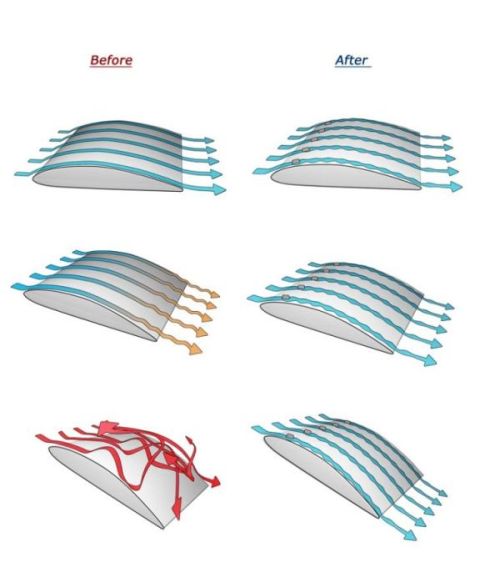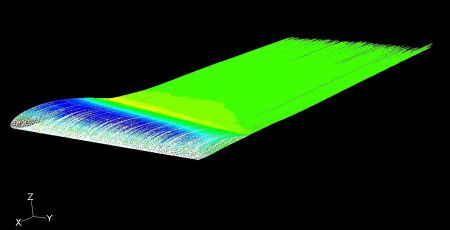
What are vortex-generators?
Vortex generators are small components deployed on the wings and stabilizers surfaces. They modify the flow around this surfaces affecting boundary layer. Properly arranged, improve the performance and controllability of the aircraft, particularly at low flight speeds, climb, and high angles of attack.
How do they work?
As stated above, the vortex generators modify the boundary layer. To understand exactly how it works, we should start by understanding the term of flow and boundary layer. To explain these concepts we should look into case of flow around solid, and in our particular case - around wings.Let's take a look to a part of flow area which is in close proximity to the surface of the flown block. This part of the flow is called the boundary layer. In the boundary layer significant are viscosity and friction forces. The viscosity of the fluid and the friction of the object surfaces generates high transverse velocity gradients. Therefore, the boundary layer is an area of particular importance. Outside the boundary layer, where viscous forces play a minor role, usually assume that the flow is inviscid. The flow in the boundary layer can be either laminar or turbulent.
Without going into too much in aerodynamics and fluid mechanics, in relation to the plane looks like this: During the flight, the air flows around the wing. The viscosity of the air and the surface friction of the wings causes the air molecules in contact with surface of the wing have zero velocity. molecules slightly farther away from the wing surface moves in the direction of flow, but they are slowed by the still ones. The farther from the wing surface, air speed is greater, up to the point where the air has a constant speed, as the speed of the incoming air. The layer of air from the surface of the wing up to this point we take as the boundary layer.
Another aspect is to explain is the nature of the flow in the boundary layer. It can be laminar or turbulent. The flow in the laminar boundary layer is "orderly and gentle". In this layer do not appear moves, perpendicular to the direction of flow, or any turbulences. Air molecules move along the gently curved paths, imposed by the flow boundaries - in our case, these paths dictates the profile of the wing. Moving air molecules to form successive layers, sliding against each other, which, despite the difference in speed, they do not mix with each other. This is because the mass and momentum transfer between the layers occurs only at the microscopic level, in a macroscopic scale, this transfer is not affected. Randomly generated disturbances are immediately damped, because the viscous forces dominate over inertial forces here. Laminar flow is called also stable flow.
In the turbulent flow particles of fluid in addition to the main movement also oscillate. Layers also move perpendicular to the direction of flow. Created are vortex structures. This flow is also called rough.

In the case of flow around a wing, boundary layer near the leading edge is thin and laminar. With the movement toward the trailing edge, gradually increasing its thickness. At a certain distance from the leading edge is a transition region in which the boundary layer changes its nature to turbulent. Despite the turbulent nature of this area, right on the wing surface, there is still a thin laminar sub layer where there is no turbulence. This is due to the dampening effects of previously mentioned viscosity. This sub-layer slows down and becomes the cause of separation and reverse flow, and thus the wing stall. To avoid separation, but rather delay the formation and reduce the intensity of separation, we should the accelerate and "energize" slowing layer. Over the years many solutions have been designed to control and influencing the boundary. A very effective yet simple solution is to use turbulators/ Vortex generators. Each of these small elements creates a swirling wake who places a energy in the boundary layer of the wing. The result is a higher critical angle of attack, a lower stall speed, gentle stall characteristics, and less tendency to "drop the wing".
Without Vortex Generators With Vortex Generators

Vortex Generators
They affect boundary layer in the flow around a airfoil.
Turbulent boundary layer is more resistant to separation. In this way it is possible to fly at a slower speed and higher angles of attack.
Vortex Generators on stabilizers act similarly improving the effectiveness of control at low speeds and with high deflections of control surfaces.
Proper location of vortex generators is very important. They should be positioned precisely in the transition region of the boundary layer. Situation is somewhat complicated by the fact that transition region, depending on the flow conditions and angle of attack, changes its position. If Vortex generators will be too close to the leading edge - will be in the laminar boundary layer and cause excessive drag during cruise, but if they are too far from the leading edge - their effectiveness at high angles of attack and low flight speed may be affected. . The optimal mounting location can be determined by computer simulations, wind tunnel testing or during test flights. For the average user, the first two methods are not available, but test flights can be performed by an experienced pilot. For most of popular airplanes information on the optimal design point of attachment is available from other users and producers. Obtaining this information from a reliable source will save you many hours of tests, many gallons fuel burned, and enjoy the benefits of safer aircraft.

CFD analysis of aircraft wing
Technical aspects of the installation are explained in available in PDF format instructions on our website. Download instruction

Benefits and features
- Shorter takeoff run.
- Lower stall speed.
- Lower approach speed.
- Higher angle of attack.
- Gentle stall characteristics.
- Increased stability at low speeds.
- Higher rate of climb.
- More effective control.
- Easy and quick installation.



